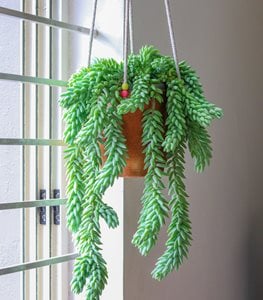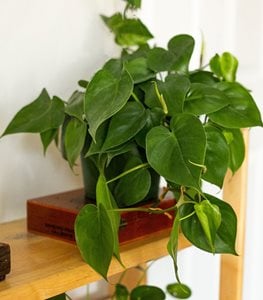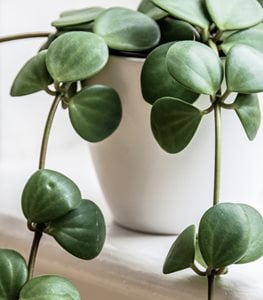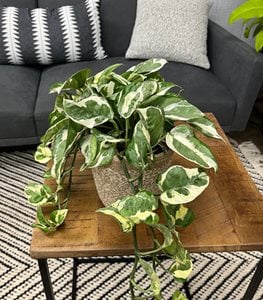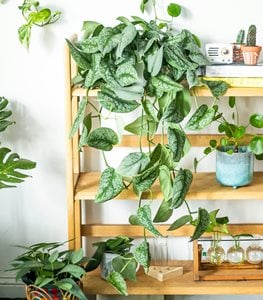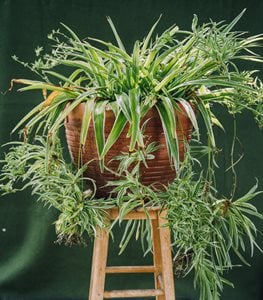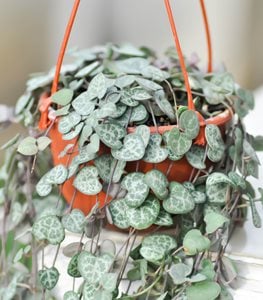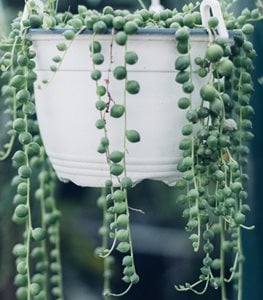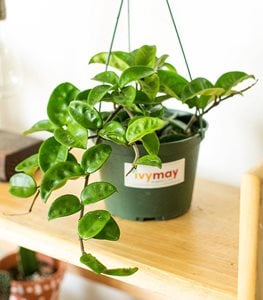10 Best Indoor Hanging Plants
Bring your indoor garden up to eye-level with these easy-care, hanging plantsYou’ve seen the Instagram posts with the hanging indoor plants suspended from the ceiling with their vines trailing down in their cute macramé hangers. It’s undeniable that creating a foliage-friendly home has become extremely popular over the last few years. Here are a few of our favorite low-maintenance hanging houseplants and how to care for them.
BURRO'S TAIL
Sedum morganianum
Burro’s Tail are a common type of flowering succulent used in arrangements or potted on their own. They feature long stems covered in juicy green leaves that almost resemble tear drops. Be careful though, these plants can get very heavy the larger they get. Their leaves are delicate and can fall off with the slightest touch, so be sure to hang it somewhere it won't be bumped in to.
- Light: Bright to full sun (full sun requires acclimation to avoid sunburn)
- Water: Allow the soil to dry between waterings to avoid root rot.
- Humidity: Average (45-55% relative humidity)
HEARTLEAF PHILODENDRON
Philodendron hederaceum
It’s easy to understand why so many people fall in love with these heart-shaped leaves. The plant has a few different variegation patterns, and many people hope to collect them all. Some of the most common ones are 'Lemon Lime', 'Brasil', 'Silver Stripe', 'Cream Splash', and 'Micans' (this one is velvety).
- Light: Low to bright indirect light
- Water: Water when the top one inch of soil has dried out.
- Humdity: Tolerant of lower humidity, but will thrive in higher levels.
Learn more about how to grow philodendron plants.
PEPEROMIA 'HOPE'
Peperomia hybrid
Also known as “trailing jade”, 'Hope' is a rarely flowering plant that grows long vines featuring green coin-shaped leaves.
- Light: Low to medium indirect or artificial light
- Water: Keep moist in spring and summer. Allow soil to dry between waterings in fall and winter.
- Humidity: Tolerant of lower levels of humidity, but appreciates at least 50% relative humidity.
Learn more about how to grow peperomia plants.
POTHOS
Epipremnum aureum
While this plant is also known as Devil’s Ivy, growing it is quite heavenly as it can thrive with minimal care—which is probably why you see them in so many businesses. Like the heartleaf philodendron, there are several different varieties of photos including golden, ‘Neon’, ‘Marble Queen’, ‘N'Joy’, ‘Manjula’, and more.
- Light: Low to high, including artificial
- Water: Water when the top one inch of soil has dried out.
- Humidity: Tolerant of lower humidity, but will thrive in higher levels.
Learn more about how to grow pothos plants.
SATIN POTHOS
Scindapsus pictus
Deep green leaves with flecks of silver, is what makes satin pothos an easy favorite of many plant lovers. Like the heartleaf philodendron and pothos, Scindapsus comes in a few varieties including ‘Argyraeus’, ‘Exotica’, ‘Silver Splash’, ‘Silvery Anne’, and ‘Jade Satin’ (this one has no silver!). This trailing houseplant gives off a more sophisticated look but is extremely easy to care for.
- Light: Medium to bright indirect light
- Water: Water when the top one inch of soil has dried out.
- Humidity: Tolerant of lower humidity, but will thrive in higher levels.
SPIDER PLANT
Chlorophytum comosum
With long, fun green and white leaves, spider plant is one of the most common hanging houseplants around. They are known to produce flowers in the spring, which will then turn into spider babies that can be removed and rooted into their own pots. Although these plants are hardy and known to handle lapses in care, they do prefer cooler temperatures over warmer ones.
- Light: Medium to (preferably) bright indirect light
- Water: Allow soil to dry between watering.
- Humidity: Can tolerate lower levels of humidity (40%), but prefers higher levels (60+%)
Learn more about how to grow spider plants.
STRING OF HEARTS
Ceropegia woodii
String of hearts plants are adored by many as they can grow extremely long vines that are covered in heart-shaped leaves that are green with silver and a pink-to-purple underside. There is also a variegated version that is primarily white with green and pink accents, which can vary by the amount of light exposure.
- Light: Meduim to bright indirect light
- Water: Allow soil to dry between watering.
- Humidity: Average (40 to 50% relative humidity)
STRING OF PEARLS
Senecio rowleyanus
String of pearls is a unique trailing succulent that resembles a pearl necklace if it were made of peas. These could be called string of peas, but please don’t eat them! A variegated version of this plant can be found featuring white striping or sections with hints of purple or pink depending on sun exposure.
- Light: Preferably bright indirect light
- Water: Allow soil to dry between watering.
- Humidity: Average (40 to 50% relative humidity)
WANDERING DUDE
Tradescantia zebrina
Regarded as one of the easiest plants to care for, the purple wandering dude features dark purple leaves with silver coloring that almost looks painted on. These dudes are generous growers, hence the wandering title.
- Light: Medium to bright indirect light. Lower light conditions cause striping to fade.
- Water: Allow soil to dry between watering.
- Humidity: Average relative humidity, but would be best around 60%.
Learn more about how to grow tradescantia plants.
WAX PLANT
Hoya carnosa
Wax plants earn their name from their thick wax-like leafy exterior and are often thought to be succulents, but they are not. While not all cultivars feature fun coloring, Hoya are known for their blooms. With the proper care, you can expect fragrant pink & red star-shaped blooms (they also secrete sticky nectar!).
- Light: Bright indirect light
- Water: Allow soil to dry between watering.
- Humidity: Will tolerate 30 to 40%, but prefers 50 to 60% relative humidity.
Learn more about how to grow hoya plants.
BONUS: AIR PLANT
Tillandsia spp.
Air plants cannot survive on air alone, but they don't require being potted in soil! And, while most air plants don’t offer long-hanging vines, tillandsias still make great hanging plants. A personal favorite is the Tillandsia xerographica with its ornate silver leaves that curl into itself creating a cute donut-like shape. If you’d like a trailing-style air plant, check out Spanish moss.
- Light: Bright indirect or filtered light
- Water: Thoroughly soak in water every two weeks or spray 2 to 3 times per week.
- Humidity: Can tolerate medium humidity levels, but prefers 60-65% relative humidity to avoid drying out.
RELATED READING:
Best Indoor Houseplants
7 Common Houseplant Pests
Common Poisonous Plants for Dogs & Cats
Common Plants Safe for Cats & Dogs
